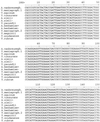rRNA gene internal transcribed spacer 1 and 2 sequences of asexual, anthropophilic dermatophytes related to Trichophyton rubrum
- PMID: 10565922
- PMCID: PMC85867
- DOI: 10.1128/JCM.37.12.4005-4011.1999
rRNA gene internal transcribed spacer 1 and 2 sequences of asexual, anthropophilic dermatophytes related to Trichophyton rubrum
Abstract
The ribosomal region spanning the two internal transcribed spacer (ITS) regions and the 5.8S ribosomal DNA region was sequenced for asexual, anthropophilic dermatophyte species with morphological similarity to Trichophyton rubrum, as well as for members of the three previously delineated, related major clades in the T. mentagrophytes complex. Representative isolates of T. raubitschekii, T. fischeri, and T. kanei were found to have ITS sequences identical to that of T. rubrum. The ITS sequences of T. soudanense and T. megninii differed from that of T. rubrum by only a small number of base pairs. Their continued status as species, however, appears to meet criteria outlined in the population genetics-based cohesion species concept of A. R. Templeton. The ITS sequence of T. tonsurans differed from that of the biologically distinct T. equinum by only 1 bp, while the ITS sequence of the recently described species T. krajdenii had a sequence identical to that of T. mentagrophytes isolates related to the teleomorph Arthroderma vanbreuseghemii.
Figures








References
-
- Bargman H, Kane J, Baxter M-L, Summerbell R C. Tinea capitis due to Trichophyton rubrum in adult women. Mycoses. 1995;38:231–234. - PubMed
-
- Burt A, Dechairo B M, Koenig G L, Carter D A, White T J, Taylor J W. Molecular markers reveal differentiation among isolates of Coccidioides immitis from California, Arizona and Texas. Mol Ecol. 1997;6:781–786. - PubMed
-
- Carbone I, Kohn L M. Ribosomal DNA sequence divergence within internal transcribed spacer 1 of the Sclerotiniaceae. Mycologia. 1993;85:415–427.
-
- de Hoog, G. S. Personal communication.
-
- English M P. Ecological aspects of dermatophytes regarded essentially as anthropophilic. In: Preusser H-J, editor. Medical mycology. Stuttgart, Germany: Gustav Fischer Verlag; 1980. pp. 53–59.
MeSH terms
Substances
Associated data
- Actions
- Actions
- Actions
- Actions
- Actions
- Actions
- Actions
- Actions
- Actions
- Actions
- Actions
- Actions
- Actions
- Actions
- Actions
- Actions
- Actions
- Actions
- Actions
- Actions
- Actions
- Actions
- Actions
- Actions
- Actions
- Actions
- Actions
- Actions
- Actions
LinkOut - more resources
Full Text Sources
Other Literature Sources

